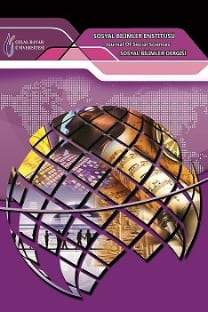Veri Görselleştirmenin Bilgi Sistemlerinde Kullanımı: Web Tabanlı Mezun Bilgi Sistemi Örneği
Son zamanlardaki veri bilimindeki yeni yaklaşımlar, verinin bilgiye dönüştürülmesi sürecindeki işleyişlerin hızlanmasını ve daha kesin sonuçlar ortaya çıkmasını sağlamıştır. Özellikle 2000’li yılların başından sonra yeni yaklaşımlar çerçevesinde, veri kavramının, gelişen teknolojiyle birlikte hayatımıza daha fazla uyumlu hale getirilmesinden sonra, büyük veri setleri ile anlamlı çıkarımlar yapmak daha kolay bir hale gelmiştir. Bu sayede hem yönetim kademelerinin işi kolaylaşmış hem de karar destek sistemlerinin daha da güçlenmesi sağlanmıştır. Bu kapsamda ortaya koyulan çalışma ile Manisa Celal Bayar Üniversitesi’ndeki yaklaşık 130.000 mezun verisi analiz edilerek sistem oluşturma aşamaları açıklanmıştır. Sonrasında ise analiz sürecinden geçen veri seti, belirli yazılım kütüphaneleri aracılığıyla görselleştirilerek, anlamlı çıkarımların ortaya konulması amaçlanmıştır. Bu amaç doğrultusunda Mezun Bilgi Sistemi (MEBİS) geliştirilerek, veriye dayalı çıkarımların yapılabilmesi hedeflenmiştir.
Anahtar Kelimeler:
Veri Görselleştirme, Karar Destek Sistemleri, Veri Analizi, Bilgi Sistemleri, Web Uygulamaları
Use Of Data Vısualızatıon In Informatıon Systems: Web Based Graduate Informatıon System Example
Recently, new approaches in data science have accelerated the process of converting data into information and resulted in more precise results. Especially after the beginning of the 2000s, within the framework of new approaches, it has become easier to make meaningful inferences with large data sets after the data concept has been made more compatible with our life with developing technology. In this way, the work of the management levels has been simplified and the decision support systems have been strengthened. Within the scope of this study, the data of approximately 130.000 graduates at Manisa Celal Bayar University were analyzed and the system creation stages were explained. Afterwards, the data set, which has gone through the analysis process, is visualized through certain software libraries and it is aimed to reveal meaningful inferences. For this purpose, it is aimed that data based inferences can be made by developing the Alumni Information System (MEBIS).
Keywords:
Data Visualization, Decision Support Systems, Data Analysis, Information Systems, Web Applications,
___
- KILIÇARSLAN, H., Büyükabalı, S., & Aktener, N. (2002). Üniversite Bilgi Sisteminde Internet Uygulamaları Deneyimleri. Akademik Bilişim, 6-8.
- EYÜPOĞLU, C., Aydın, M. A., Sertbaş, A., Zaim, A. H., & Öneş, O. (2017). Büyük Veride Kişi Mahremiyetinin Korunması. Bilişim Teknolojileri Dergisi, 10(2), 177-184.
- GHOSH, S., Datta, A., Tan, K., & Choi, H. (2018). SLIDE–a web-based tool for interactive visualization of large-scale–omics data. Bioinformatics, 35(2), 346-348.
- LAUDON, K. C., & Laudon, J. P. (1999). Management information systems. Prentice Hall PTR.
- GÓMEZ, J., García, L. J., Salazar, G. A., Villaveces, J., Gore, S., García, A., ... & Dumousseau, M. (2013). BioJS: an open source JavaScript framework for biological data visualization. Bioinformatics, 29(8), 1103-1104.
- BİLGİN, T. T., & Çamurcu, A. Y. (2008). Çok Boyutlu Veri Görselleştirme Teknikleri. Akademik Bilişim, 30, 107-112.
- STOREY, V. C., & Song, I. Y. (2017). Big data technologies and management: What conceptual modeling can do. Data & Knowledge Engineering, 108, 50-67.
- FİORİNİ, M., Capata, A., & Bloisi, D. D. (2016). AIS data visualization for maritime spatial planning (MSP). International Journal of e-Navigation and Maritime Economy, 5, 45-60.
- JOSEPH, A. D., Katz, R., Konwinski, A., Gunho, L. E. E., Patterson, D., & Rabkin, A. (2010). A view of cloud computing. Communications of the ACM, 53(4).
- SRİNİVASAN, A., Drucker, S. M., Endert, A., & Stasko, J. (2019). Augmenting visualizations with interactive data facts to facilitate interpretation and communication. IEEE transactions on visualization and computer graphics, 25(1), 672-681.
- FONSECA, J., Seixas, N., Vieira, M., & Madeira, H. (2014). Analysis of field data on web security vulnerabilities. IEEE transactions on dependable and secure computing, 11(2), 89-100.
- JACOB, N. M. (2016). Vulnerability of data security using MD5 function in php database design. International Journal of Science and Engineering (IJSE).
- Mevzuat Bilgi Sistemi, “Kişisel Verilerin Korunması Kanunu(https://www.mevzuat.gov.tr/MevzuatMetin/1.5.6698.pdf), (09.01.2019)
- WANG, L., Wang, G., & Alexander, C. A. (2015). Big data and visualization: methods, challenges and technology progress. Digital Technologies, 1(1), 33-38.
- KESSLER, G. C. (2016). The Impact of MD5 File Hash Collisions on Digital Forensic Imaging. Journal of Digital Forensics, Security and Law, 11(4), 9.
- ÇUKURÇAYIR, M. A., & Çelebi, E. (2012). Bilgi toplumu ve e-devletleşme sürecinde Türkiye. Uluslararası Yönetim İktisat ve İşletme Dergisi, 5(9), 59-82.
- PageSpeed Insight, “Web Pages Fast Test on All Devices (https://developers.google.com/speed/pagespeed/insights/), (24.12.2018)
- CHAUHAN, N. S., & Saxena, A. (2013). A green software development life cycle for cloud computing. IT Professional, 15(1), 28-34.
- LUO, S., Gao, Z., Gubanov, M., Perez, L. L., & Jermaine, C. (2018). Scalable linear algebra on a relational database system. IEEE Transactions on Knowledge and Data Engineering.
- SPİLLANE, J. P. (2012). Data in practice: Conceptualizing the data-based decision-making phenomena. American Journal of Education, 118(2), 113-141.
- SHOKHRİN, A., & Carter, K. D. (2017). Methods, systems, and computer readable media for authorization frameworks for web-based applications. U.S. Patent No. 9,591,000. Washington, DC: U.S. Patent and Trademark Office.
- ISSN: 1304-4796
- Yayın Aralığı: Yılda 4 Sayı
- Başlangıç: 2003
- Yayıncı: Manisa Celal Bayar Üniversitesi
Sayıdaki Diğer Makaleler
Edebiyatımızda Kaside-i Münferice Geleneği ve Ebu Bekir Kânî’nin Manzum Kaside-i Münferice Tercümesi
Melda Meliha ERBAŞ, Tevfik Fikret KARAHAN, Tunahan UZUN
Merhamet ve Merhamet Odaklı Terapi
Kuantum Mekaniği, Sosyal Bilimler Felsefesi ve Coğrafya
Münür BİLGİLİ, Mehmet Ali TOPRAK
Erken Bizans Dönemi Mimarisinde Az Bilinen Bir Düzenleme: Thalassidionlar
İlköğretim Matematik Öğretmeni Adaylarının Etkinlik Kavramına Yönelik Algılarının İncelenmesi
